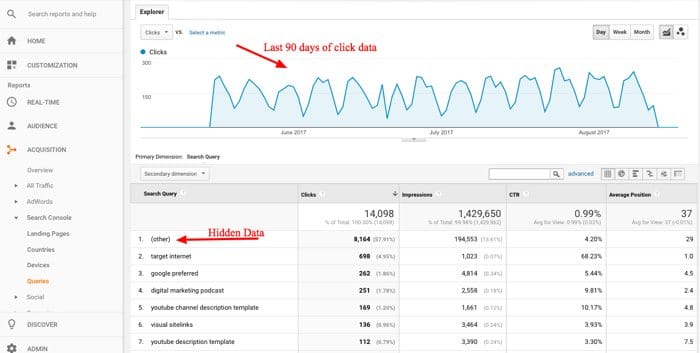In this guide, you will learn how to see keywords in Google Analytics. You will also learn how to track keywords in Google Analytics so that you can get a full keyword performance report for your website by linking your account to Google Search Console. Most people are familiar with the first method for checking keywords in their Google Universal Analytics accounts (described directly below), but they are a little overwhelmed with the available keyword ranking data.
Also, this data does not exist initially in Google Analytics 4 (GA4). However, there is another – and more useful – way to view organic keywords in your Google Universal Analytics account so you can see all the keywords your website is ranking for, including clicks and impressions, see “CTR” “. And the “average search position” for each keyword provides traffic from the Google search engine. You can also set up your new GA4 account to receive the same data.
So be sure to read both parts of this SEO tutorial below to properly set everything up for Universal and GA4 Analytics. Part 1 shows you how to identify the best keywords in 6 steps and Part 2 teaches you how to track the performance of organic keywords in 7 steps.
You may like to read: How To Find competitive Keywords?
How to view keywords in Google Analytics
1. Open Google Analytics
The first step how to view keywords in Google Analytics is to go to your Google Universal Analytics account by going to analytics.google.com. This will take you to the main Google Analytics dashboard and display general SEO tracking data for your linked website.
Note: Google Analytics 4 (GA4) does not display any keyword data by default. The next section of this guide on keyword tracking will help you set up GA4 to display keyword data.
2. Go to the Acquisition tab
The next step is to look at the Reports section on the left side of your Google Analytics dashboard and click on the Acquisition tab to open it. The Acquisition report section of Google Analytics is used to determine how users enter your website. For this SEO tutorial, all we care about is organic search traffic for the keywords that Google tracks. So in the next step, we will go directly to this subsection.
3. Click All Traffic
Google Analytics keyword data is hidden deep within the provisioning section. So you need to click on the All Traffic tab to open that area to get closer to the SEO data you want.
4. Open the Source/Medium report
The next step is to open the Source/Medium report, which will take you one step closer to seeing your website’s keyword rankings in Google Analytics. In the first view here, you should see “google/free” in the first column, followed by acquisition metrics like “users,” “new users,” “sessions,” “bounce rate,” “pages/sessions,” “average.”. session duration” and so on
5. See the Keywords tab in Google Analytics
After opening the “Source/Medium” section, the next step is to click on the “Keyword” tab, so you can check the performance of the incoming keywords in Google Analytics.
6. View the list of keywords that are being reported
After clicking on the “Keyword” tab, you will finally see a list of keywords in your Google Analytics dashboard. However, this list will most likely contain a few numbered rows and very few actual keywords for your website. What ranks first in the list of keywords with the most users, sessions, and page views?
These two keywords are:
- (not supplied)
- (not set)
Unfortunately, Google Analytics does not show specific keyword data for your website. In 2011, Google decided to make search safer and protect the privacy of its users by hiding their search results.
This advertisement states:
“To help you better identify organic search traffic from a logged-in user, we’ve created the code ‘(not available)’ in the organic search traffic keyword report. You’ll still see referrals unchanged. Only a logged-in user’s traffic requests will be affected.”
As for the (unset) value, here’s what Google says:
“(unset) is the name of the property that Analytics uses when it receives no data on the dimension you chose.”
In short, what all this means is that if a user lands on your website by doing a Google search, Google Analytics will identify the visitor in the organic source media, but show you the search term they used to get to the site. does not give.
But do not worry …
While this part of Google Analytics doesn’t provide any useful keyword performance data, there is another powerful way to view, review, and track the SEO keywords that people use to land on your web pages, and how to do it is below. you will learn.
How to track keywords in Google Analytics (Global)
1. Set up a Google Search Console account
The first step how to track keywords in a Google Analytics Universal Account (or UA) is to create a Google Search Console account. To do this, go to search.google.com/search-console/ and follow the steps below to set up your new website for tracking:
- Sign in to Google Search Console.
- Click “Find a feature” in the upper left corner of the control panel to open the drop-down menu.
- Select “Add property”.
- Enter the website address
- A popup will appear with two options. Select the “URL Prefix” option, which is the easiest option to implement, and then enter your website address.
- Then click the Continue button.
- Choose a method to verify ownership of your URL. The HTML file upload option is the easiest.
- Then press the “Confirm” button.
- After completing the previous step, Google Analytics will take a few minutes to complete the verification process and you will see a confirmation message once your ownership is verified.
- Finally, click Go to Property to display your website on the homepage of the Google Search Console dashboard.
2. Connect Google Search Console to Google Analytics
After you have verified your website using Google Search Console, you will need to link it to your Google Analytics account. After linking these two Google features, you can track keywords in Google Analytics. Step 3 shows you how to create this link to display your SEO keywords.
3. Open your Google Analytics account
This step describes how to associate Google Search Console data with Google Universal and GA4 Analytics. First, we’ll cover the step-by-step instructions, then we’ll show you pictures of each process in action. Google Universal Analytics account linking process:
- Go to your Analytics account by visiting analytics.google.com.
- Make sure that you select the correct site (website) in Google Universal Analytics that matches the site you set up in Google Search Console in Step 1.
- Then click on the “Administrator” button located in the left menu at the bottom of the Google Analytics dashboard.
- On the Administrator Settings page, the second column is called “Location”. Inside this column, click on the All Products tab.
The next page
- On the next page, go to the “Search Console” section, and then click on the “Link Search Console” button.
- Then click “Add”.
- Then select the correct website address to connect to Google Search Console. This URL will be the same as the URL created in Step 1.
- Once you have selected the correct website address, click OK to successfully connect your Google Search Console and Google Analytics account.
- Now, keep in mind that Google Search Console can take several days to collect and report all tracked keyword data for your website. So be patient if you don’t see any tracking information after following the steps below in this guide.
4. Go to the Acquisition tab to track keywords
After linking your Google Analytics and Search Console accounts and your website data, you can view your keyword list in Google Analytics. To do this, you must first click on the “Acquisition” tab on the left side of the dashboard to open this section of the SEO report.
5. Click on Search Console
After opening the Acquisition section, click on the “Search Console” sub-section to open this section to get one step closer to checking your website’s actual keyword rankings.

6- Open the Search Queries report to review keyword data
Next, click on the “Queries” tab to open this section of the Google Analytics dashboard. Here you will find the full list of keywords tracked in Google Search Console and displayed in your Google Analytics account.
The first column is titled “Search Queries” which will show you the exact keywords your website is ranking for and driving traffic to your website. You can sort this keyword’s performance data by clicking on the column table headers for Clicks, Impressions, CTR, and Average Search Position to see how different keywords perform against these tracked metrics.
If you want to check Google Analytics keywords for a particular landing page, you can do that as well. For a complete list of your website URLs, simply click on the “Landing Pages” tab in the left menu under the “Search Console” section. Then, click on an individual URL to see what keywords the page is ranking for in Google search engines.
7. Change the tracking history to view keywords over time
The final step to keyword tracking in Google Analytics is to see how well you are tracking your keywords over time. You can set the reporting date in Google Analytics to display a custom period, or choose default date range options such as ‘Today’, ‘Yesterday’, ‘Last week’, ‘Last month’, ‘Last 7 days or ‘ Last. “. 30 days”. In addition, you can compare a specific date range with other periods, including the Previous Period, Previous Year, or Custom period.
I hope you enjoyed this guide on how to view keywords in Google Analytics.
As you can see, the primary way to use Analytics for keyword research is to limit keyword performance data for SEO. You will usually see most tracked data entered as (not available) or (not specified). The best way to track keywords in Google Analytics is to link your website feature to a Search Console account. Once the two accounts are linked, you can view all of your keywords in Google Analytics and generate more detailed reports to assess your site’s SEO performance.
Go to next post







Leave a Comment